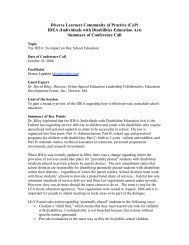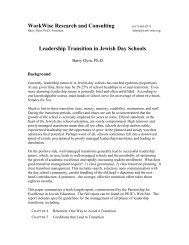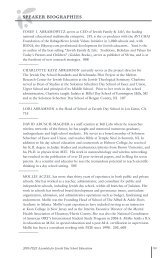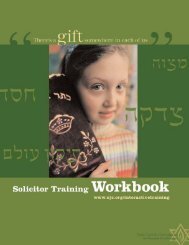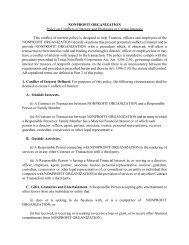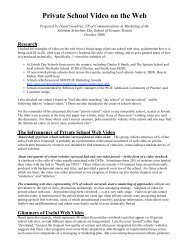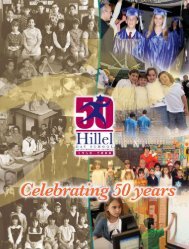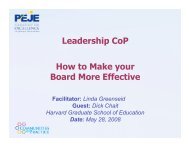âA Lifetim e of Learningâ - Partnership for Excellence in Jewish ...
âA Lifetim e of Learningâ - Partnership for Excellence in Jewish ...
âA Lifetim e of Learningâ - Partnership for Excellence in Jewish ...
Create successful ePaper yourself
Turn your PDF publications into a flip-book with our unique Google optimized e-Paper software.
daism. Should conversion not take place, the chances that childrenwill be raised exclusively as Jews are higher <strong>in</strong> marriages where the<strong>Jewish</strong> spouses have undergone more extensive and <strong>in</strong>tensive <strong>Jewish</strong>educational experiences. In other words, even <strong>in</strong> the event <strong>of</strong> <strong>in</strong>itial<strong>in</strong>termarriage, accumulated <strong>Jewish</strong> education serves to furtherchances <strong>of</strong> <strong>Jewish</strong> cont<strong>in</strong>uity, either by <strong>in</strong>creas<strong>in</strong>g the likelihood <strong>of</strong>conversion (mak<strong>in</strong>g the <strong>in</strong>termarriage an <strong>in</strong>-marriage) or by <strong>in</strong>creas<strong>in</strong>gthe likelihood that the mixed married couple will raise its childrenexclusively <strong>in</strong> Judaism.PROMOTE EDUCATIONAL PARTICIPATION:LINK EXPERIENCESClearly, the <strong>Jewish</strong> community has a strong <strong>in</strong>terest <strong>in</strong> promot<strong>in</strong>g<strong>Jewish</strong> education. The question is how to do that. In recent years,organized Jewry has <strong>in</strong>deed expanded participation <strong>in</strong> most major<strong>for</strong>ms <strong>of</strong> <strong>Jewish</strong> education, <strong>in</strong>clud<strong>in</strong>g <strong>Jewish</strong> pre-schools, dayschools, Israel travel, <strong>Jewish</strong> studies courses, and adult <strong>Jewish</strong> education.Advocates <strong>for</strong> <strong>Jewish</strong> education have <strong>in</strong>creased capacity (moreschools, more camp beds), lowered costs (vouchers, free trips to Israel),enlarged personnel tra<strong>in</strong><strong>in</strong>g programs, supported teachersalaries and benefits, developed better market<strong>in</strong>g, and strengthenedboards. One approach yet to receive much attention is that which focuseson improv<strong>in</strong>g the l<strong>in</strong>kages among various educational experiences— that is, expand<strong>in</strong>g the flow <strong>of</strong> students between and amongdifferent venues <strong>for</strong> <strong>Jewish</strong> education. This policy seeks to expandrecruitment by turn<strong>in</strong>g to the most likely candidates <strong>for</strong> more <strong>Jewish</strong>education — those who already experience some education.Participants <strong>in</strong> one <strong>for</strong>m <strong>of</strong> education are likely to participate <strong>in</strong> simultaneousor succeed<strong>in</strong>g <strong>for</strong>ms. Those who attend pre-schools arefar more likely than others to move on to day schools, and eventually<strong>Jewish</strong> camp<strong>in</strong>g, youth groups, and Israel experiences. Dayschool students disproportionately participate <strong>in</strong> the <strong>in</strong><strong>for</strong>mal <strong>Jewish</strong>teen experiences, just as campers and youth group membersoverlap, and both are likely sources <strong>of</strong> participants <strong>in</strong> high schooltrips to Israel. Many youngsters certa<strong>in</strong>ly move from one experienceto another, but the rate at which they do so is far from universal andleaves much room <strong>for</strong> further expansion.PROSPECTS FOR THE FUTUREAbout half <strong>of</strong> all American Jews 22-39 years old are unmarried.Synagogues, JCCs and <strong>Jewish</strong> organizational life generally exertlittle appeal <strong>for</strong> them, leav<strong>in</strong>g a majority <strong>of</strong> this demographicsegment <strong>in</strong>stitutionally unaffiliated. But their lack <strong>of</strong> affiliationshould not be taken as a lack <strong>of</strong> engagement with be<strong>in</strong>g <strong>Jewish</strong>.After all, if past behavior is any guide, the vast majority (over 90%)will marry; about half <strong>of</strong> those who marry will marry Jews; and, <strong>of</strong>these <strong>in</strong>-married, over 80% will at some po<strong>in</strong>t affiliate with a <strong>Jewish</strong><strong>in</strong>stitution. Of the half who will marry non-Jews, most will reportfeel<strong>in</strong>g positively about be<strong>in</strong>g <strong>Jewish</strong>, although the evidence regard<strong>in</strong>ghow they raise their children shows that positive feel<strong>in</strong>gs <strong>for</strong>be<strong>in</strong>g <strong>Jewish</strong> do not generally translate <strong>in</strong>to effective behavior thatsusta<strong>in</strong>s <strong>Jewish</strong> cont<strong>in</strong>uity. At the same time, notwithstand<strong>in</strong>g themajor differences between <strong>in</strong>-married and <strong>in</strong>termarried, we shouldnot be led to believe that the <strong>in</strong>-married’s <strong>Jewish</strong> future is assured.For the non-married, synagogues, JCCs and organizational lifeare not particularly effective <strong>in</strong> br<strong>in</strong>g<strong>in</strong>g these Jews together. Thus,cultural events and social service opportunities may <strong>of</strong>fer the bestalternatives <strong>for</strong> per<strong>for</strong>m<strong>in</strong>g that function. Of course, one can (andshould) make other arguments on behalf <strong>of</strong> a culturally rich andsocially engaged <strong>Jewish</strong> community; but the social network<strong>in</strong>g functionalone would seem to justify these endeavors as worthy <strong>of</strong> <strong>Jewish</strong>communal and philanthropic support.No s<strong>in</strong>gle program or social policy <strong>of</strong>fers the possibility <strong>of</strong> sweep<strong>in</strong>gand immediate change <strong>in</strong> outcomes. No magic bullet will guaranteea culturally vital <strong>Jewish</strong> community <strong>in</strong> America that will engage thevast majority <strong>of</strong> Jews. Rather, the cumulative and <strong>in</strong>teractive effect<strong>of</strong> the multiplicity <strong>of</strong> <strong>in</strong>struments <strong>of</strong> <strong>Jewish</strong> education and socializationcan have a pr<strong>of</strong>ound impact on American Jews as a whole, asthey do now <strong>for</strong> only select numbers <strong>of</strong> American Jews. To take oneexample, the comb<strong>in</strong>ed net impact <strong>of</strong> day school, youth group,<strong>Jewish</strong> camp, and Israel experience upon <strong>in</strong>termarriage amounts toapproximately 30 percentage po<strong>in</strong>ts, enough to more than halve theA P U B L I C A T I O N O F Y I T Z H A K R A B I N H I G H S C H O O LUn<strong>for</strong>tunately, most pr<strong>of</strong>essional directors <strong>of</strong> pre-schools, dayschools, camps, and youth groups seem to make little ef<strong>for</strong>t to recruiton behalf <strong>of</strong> other educational experiences that may co<strong>in</strong>cidewith, or follow upon, their own. Much more can be done to mobilize,motivate, and <strong>in</strong>centivize the directors <strong>of</strong> the respectiveeducational agencies to encourage their students and participantsto consider other <strong>for</strong>ms <strong>of</strong> <strong>Jewish</strong> education. Of all theas yet untried techniques <strong>for</strong> <strong>in</strong>creas<strong>in</strong>g enrollments <strong>in</strong> dayschools, camps, youth groups, and Israel experience programs,this route may be the most effective.“ A L i f e t i m e o f L e a r n i n g ” • P A G E 21



